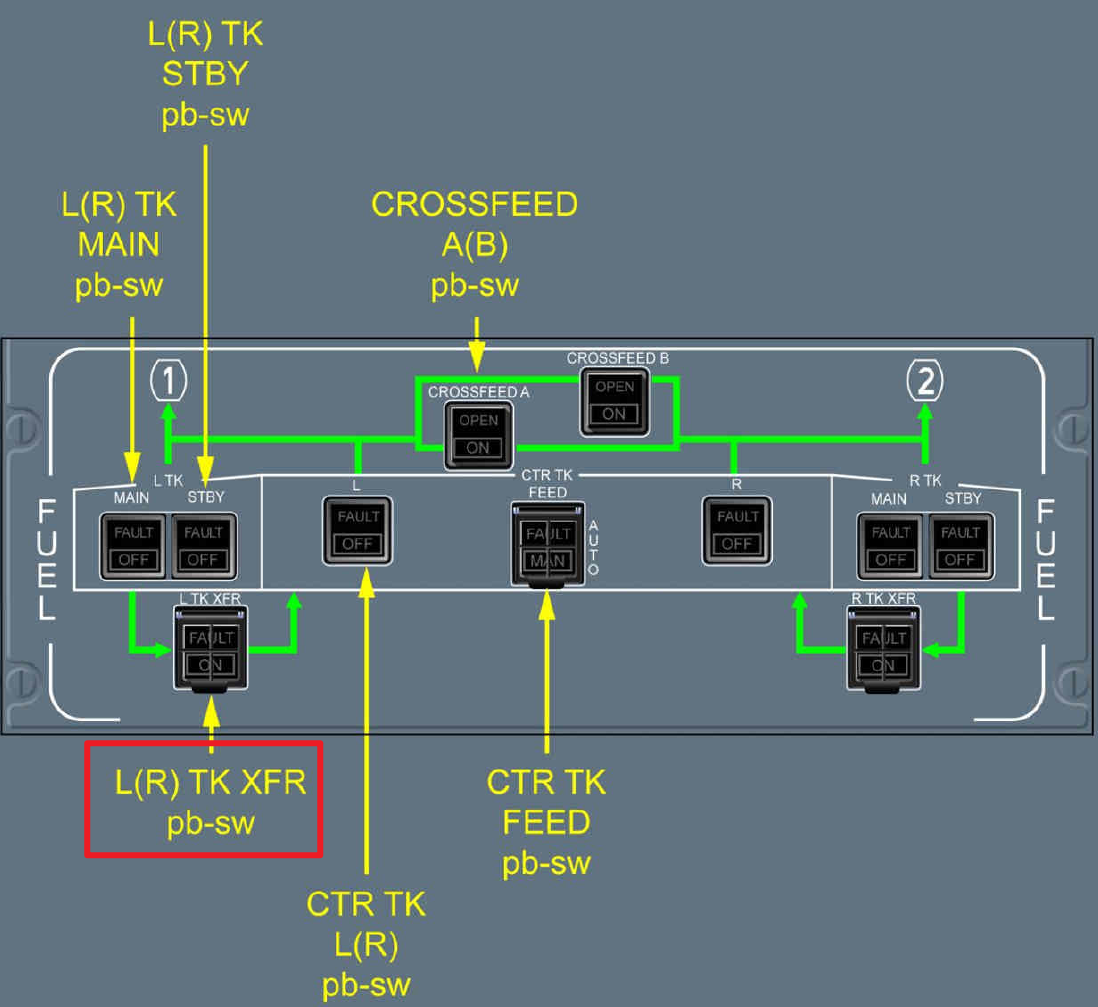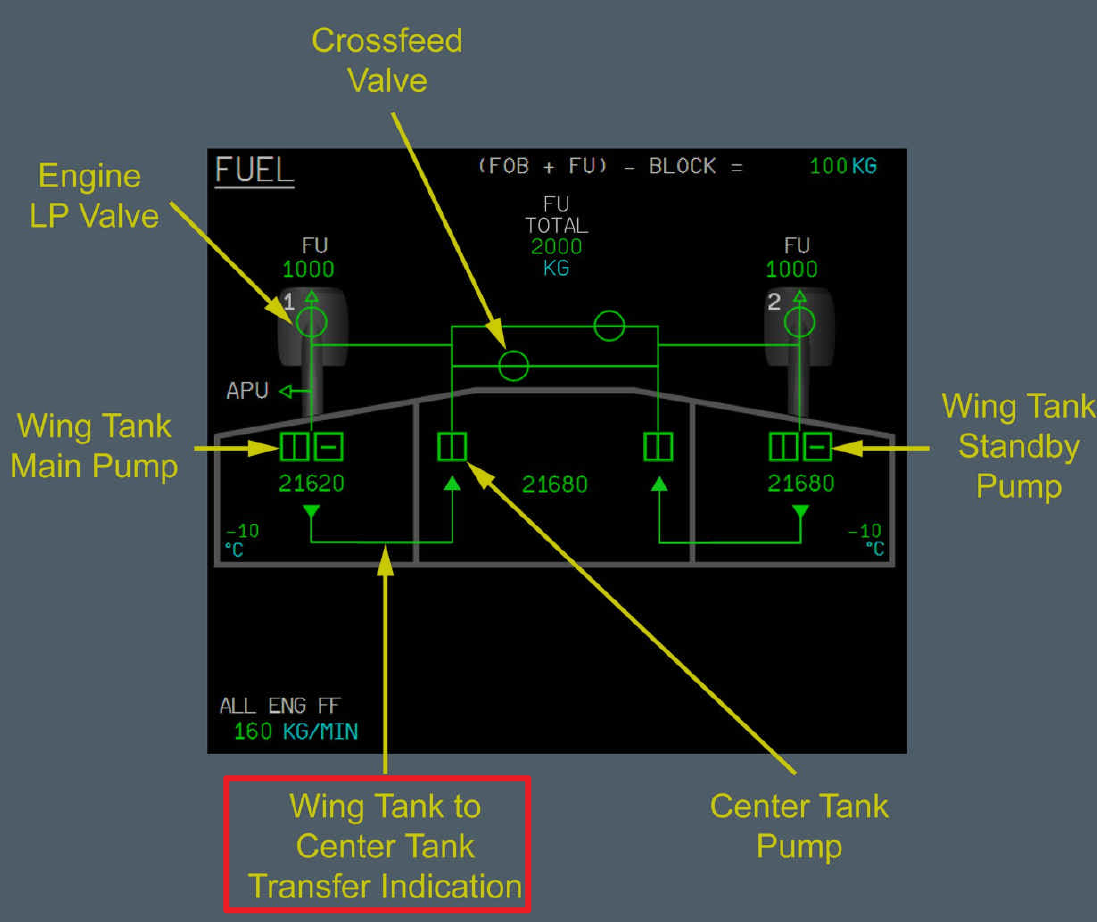A350 дҪҝз”ЁL(R) TK XFR жҢүй’®жҺҘйҖҡпјҢеҸҜд»Ҙжү“ејҖеҠ жІ№з®Ўи·ҜдёӯжңәзҝјжІ№з®ұе’ҢдёӯеӨ®жІ№з®ұзҡ„ INLET VALVEпјҢжңәзҝјжІ№з®ұзҡ„жІ№дјҡйҮҚеҠӣдј иҫ“еҲ°дёӯеӨ®жІ№з®ұгҖӮиҝҷз§ҚйҖ”еҫ„дёҖиҲ¬жҳҜеңЁдәӨиҫ“жҙ»й—ЁдёҚе·ҘдҪңпјҲж•…йҡңжҲ–иҖ…иў«иҰҒжұӮе…ій—ӯпјүпјҢд»ҘеҸҠжңәзҝјжІ№з®ұжіөдёҚе·ҘдҪңзҡ„ж—¶еҖҷдјҡз”ЁеҲ°гҖӮ
FUEL CROSSFEED VLV A+B FAULT зҡ„зЁӢеәҸпјҡ
йӮЈеҰӮжһңйҒҮеҲ°жңәзҝјжІ№з®ұжі„жјҸпјҢз”Ё TK XFR жқҘе°ҶжңәзҝјжІ№з®ұзҡ„дј иҫ“еҲ°дёӯеӨ®жІ№з®ұпјҢдёҚе°ұеҸҜд»Ҙе°ҪеҸҜиғҪзҡ„дҝқеӯҳдёҖдәӣзҮғжІ№д№ҲпјҹдҪҶзЁӢеәҸйҮҢ并没жңүиҝҷдёӘеҠЁдҪңгҖӮ
иҝҷдёӘй—®йўҳжқҘжқҘеӣһеӣһй—®дәҶз©әе®ў3ж¬ЎгҖӮ第дёҖж¬Ўеӣһзӯ”иҜҙ TK XFR дј иҫ“йҖҹзҺҮеҫҲдҪҺпјҢдёҺжјҸжІ№зӣёжҜ”еҸҜд»ҘеҝҪз•ҘпјҢж„Ҹд№үдёҚеӨ§гҖӮжҲ‘еҸҲй—®еҫҲдҪҺжҳҜз”ұеӨҡдҪҺпјҢеҶҚдҪҺд№ҹиғҪдҝқеӯҳдёҖйғЁеҲҶзҮғжІ№еҗ§пјҢиҖҢдё”еңЁ FUEL L(R) MAIN+STBY PMPs FAULT дёӯпјҢеҪ“дҪҝз”Ё TK XFR еҗ‘дёӯеӨ®жІ№з®ұдј иҫ“зҮғжІ№д№ӢеҗҺпјҢйғҪеҸҜд»Ҙз”ЁжқҘдҝқиҜҒеҸ‘еҠЁжңәдҫӣжІ№пјҢиҜҙжҳҺдј иҫ“йҖҹзҺҮи¶…иҝҮеҸ‘еҠЁжңәжІ№иҖ—йҖҹзҺҮпјҢдёҚз®—дҪҺдәҶгҖӮ
第дәҢж¬Ўз©әе®ўзҡ„еӣһеӨҚе®Ңе…Ёй”ҷиҜҜпјҢжІЎжңүеҸҜеҸӮиҖғжҖ§гҖӮзҹҘйҒ“第дёүж¬ЎжүҚз»ҷеҮәдәҶдёҖдёӘеӢүејәеҸҜд»ҘжӢҝжқҘи®Ёи®әзҡ„иҜҙжі•
з©әе®ўи®ӨдёәпјҢд»ҺзҗҶи®әдёҠи®ІеҫҲйҡҫеҮәзҺ°еӨ§йҮҸзҮғжІ№зҡ„зӣҙжҺҘжі„жјҸпјҲиҝҷе°ұе·Із»ҸдёҺ第дёҖж¬Ўзҡ„еӣһеӨҚдёҚдёҖиҮҙдәҶпјүпјҢе®һйҷ…иҝҗиЎҢдёӯд№ҹжІЎжңүеҮәзҺ°иҝҮиҝҷж ·зҡ„дәӢ件пјҢжүҖд»ҘиҖғиҷ‘еҲ°зҮғжІ№зҡ„еҸҜз”ЁйҖ”еҫ„пјҢжңҖеҘҪиҝҳжҳҜдҝқз•ҷеңЁжңәзҝјжІ№з®ұгҖӮеӣ дёәиҝҷж ·еҸҜд»ҘйҖҡиҝҮжңәзҝјжІ№з®ұжІ№жіөдҫӣжІ№гҖҒйҮҚеҠӣдҫӣжІ№пјҢжңҖеҗҺиҝҳеҸҜд»Ҙдј иҫ“еҲ°дёӯеӨ®жІ№з®ұйҖҡиҝҮдёӯеӨ®жІ№з®ұжіөдҫӣжІ№гҖӮдҪҶеҰӮжһңе·Із»Ҹдј иҫ“еҲ°дәҶдёӯеӨ®жІ№з®ұпјҢе°ұеҸӘиғҪйҖҡиҝҮдёӯеӨ®жІ№з®ұжіөдҫӣжІ№пјҢеҸҜз”ЁйҖ”еҫ„е°ұеҮҸе°‘дәҶгҖӮеҒҮи®ҫеҶҚдјҙйҡҸдёҖдәӣ MEL, жҜ”еҰӮдёҖдёӘдёӯеӨ®жІ№з®ұжіөдёҚеҸҜз”ЁпјҢеҪ“йҒҮеҲ°еҸҰдёҖдёӘдёӯеӨ®жІ№з®ұжіөд№ҹж•…йҡңж—¶пјҢиҝҷйғЁеҲҶжІ№е°ұеҪ»еә•дёҚеҸҜз”ЁдәҶгҖӮ
иҝҷдёӘи§ЈйҮҠжҸҗдҫӣдәҶеҸҰеӨ–дёҖз§ҚиҖғиҷ‘й—®йўҳзҡ„и§Ҷи§’пјҢеҚідҝқз•ҷжӣҙеӨҡдҪҝз”ЁйҖ”еҫ„гҖӮиҝҷж ·еҒҡжңүеҘҪеӨ„д№ҹжңүйЈҺйҷ©пјҢдҪҶз©ә客并没жңүиҜҙжҳҺжҳҜеҗҰй’ҲеҜ№дёҚеҗҢзҡ„ж•…йҡңжғ…еҶөиҜ„дј°иҝҮйЈҺйҷ©еҖјгҖӮжҳҜеңЁжүҖжңүжғ…еҶөдёӢпјҢдёҚдҪҝз”Ё TK XFR зҡ„йЈҺйҷ©еҖјйғҪе°ҸдәҺдҪҝз”ЁпјҢиҝҳжҳҜеҸҜд»Ҙж №жҚ®жғ…еҶөжқҘйҖүжӢ©гҖӮжҜ•з«ҹдёҠиҝ°дҫӢеӯҗдёӯдёӨдёӘдёӯеӨ®жІ№з®ұжіөеҸҲйғҪеқҸжҺүзҡ„жҰӮзҺҮд№ҹжҳҜзӣёеҪ“зҡ„дҪҺпјҢиҜҙжңҚеҠӣе®һеңЁжңүйҷҗгҖӮ
йүҙдәҺеҶҚеӨҡж¬ЎжІҹйҖҡдёӯпјҢз”ұдәҺиҜӯиЁҖиЎЁиҫҫзҡ„дёҖдәӣйҡңзўҚгҖҒе…іжіЁзӮ№дёҚе®Ңе…Ёз»ҹдёҖгҖҒд»ҘеҸҠз©әе®ўеҜ№жҹҗдәӣз»ҶиҠӮдёҚж„ҝж„ҸжҠҠиҜқиҜҙжӯ»зҡ„д№ жғҜпјҢжҲ‘дёҚеҮҶеӨҮеҶҚеҺ»иҜҒе®һгҖӮдҪҶиҝҷе·Із»Ҹи®©жҲ‘дәҶи§ЈдәҶз©әе®ўеңЁзЁӢеәҸдёӯзҡ„иҖғйҮҸпјҢеҰӮжһңеңЁе®һйҷ…йЈһиЎҢдёӯзңҹзҡ„йҒҮеҲ°зҮғжІ№жі„жјҸпјҢиғҪеӨҹз»ҷеҶізӯ–жҸҗдҫӣжӣҙеӨҡзҡ„ж”ҜжҢҒгҖӮе…·дҪ“ең°иҜҙпјҢеңЁзҮғжІ№жі„жјҸйҖҹзҺҮиҝҮеҝ«пјҢжҲ–иҖ…еү©дҪҷзҮғжІ№е·Із»Ҹйқһеёёзҙ§еј зҡ„жғ…еҶөдёӢпјҢжҲ‘и®ӨдёәдҪҝз”Ё TK XFR е°ҪйҮҸдҝқеӯҳзҮғжІ№жҳҜжӣҙеҘҪзҡ„йҖүжӢ©гҖӮ
TechRequest еҺҹж–Үпјҡ
Q:
In FUEL CROSSFEED VLV A+B FAULT, we can use fuel in opposite tank by transferring fuel from wing tank to center tank.
In case of fuel leak is confirmed from wing tank instead of eng, why not using the same way to save fuel? Fuel can be transferred to center tank as much as possible, then it can feed eng by ctr tk pump.
A:
In normal operation, fuel transfer from a wing to center tank is not required, however in-flight the crew can initiate a manual gravity transfer via the L/R Tank XFR PB-SW in overhead panel AS REQUESTED BY ECAM.
Operating the L/R TK XFR BP SW is not included in the FUEL LEAK procedure, therefore during the FUEL LEAK procedure the crew shall strictly follow the ABN FUEL LEAK procedure.
Note: The rate of gravity fuel transfer from WING to CENTER tank is relatively low, therefore negligible when compared to the rate of fuel leak loss!
Q_2:
I still have some concerns about TK XFR.
Fisrtly, there is not a standard for rate of fuel leak, how to compare with tha rate of fuel transfer from wing center? Secondly, whatever the rate, there's no disadventage of this transfer. If this part of fuel is not transfered to center tank, the only way is just leaking. It's obvious which way is better. We should save the fuel as much as posisble.
A_2:
On A350 the fuel pumps allow a faster transfer from wings to the center tank for the remaining operative engine and minimize the fuel leak. But they may lead to an unbalanced aircraft.
Therefore, the вҖңCrossfeed VLV A+B FAULTвҖқ procedure uses the manual gravity transfer L(R) TK XFR ON: this procedure is not dedicated to the fuel leak.
Q_3:
I don't understand your last answer. Maybe the previous quesitons ae not so clear, I'm going to express again. In fuel leak procedure, if wing leak is confirmed, we should restart the engine to maximum use the fuel. What I considered is why can't we use TK XFR to save some fuel from leaking wing tank to center tank.
Answer at the first time is "rate of gravity fuel transfer from WING to CENTER tank is relatively low". But no matter how low the rate is, it can still save some fuel without any disadventage.
Answer at the second time made me confused. How does "fuel pumps allow a faster transfer from wings to the center tank"? Can fuel pump transfer fuel from wing to center tank in the situation of wing tank leak, or even in normal feeding condition? And how do "they may lead to an unbalanced aircraft". Due to wing leak, at last one wing tank will be empty. The severity of unbalance depends on the fuel quantity of opposite wing tank, other than the fuel quantity of center tank. It has already unbalanced.
So back to the question. Why can't we turn on L(R) TK XFR when L(R) wing tank leak is confirmed?
A_3:
We regret that there was an error in the last answer, as there is no pumped transfer between the wing tank and the center tank. This is is a gravity transfer as mentioned in FCOM :
Then, in the case of a fuel leak, it is extremely unlikely to be a direct and large fuel leak from a tank, as per structures design requirements. Also experience does not show examples of important and sudden tank leak. Therefore, considering the fuel availability, it remains preferable to keep the fuel in the wing tank, since the fuel from the wing tank can be sent to engine via the fuel pumps, sent to the engine via gravity suction, or ultimately sent to the center tank to be then pumped to the engine.
On the other hand, the center tank fuel can only be pumped by one of the two center tank pumps, so it is less available to the engines in the case of a failure. In the case of a center tank fuel pump under MMEL for example, the entire center tank fuel can be trapped if the second pump fails.




